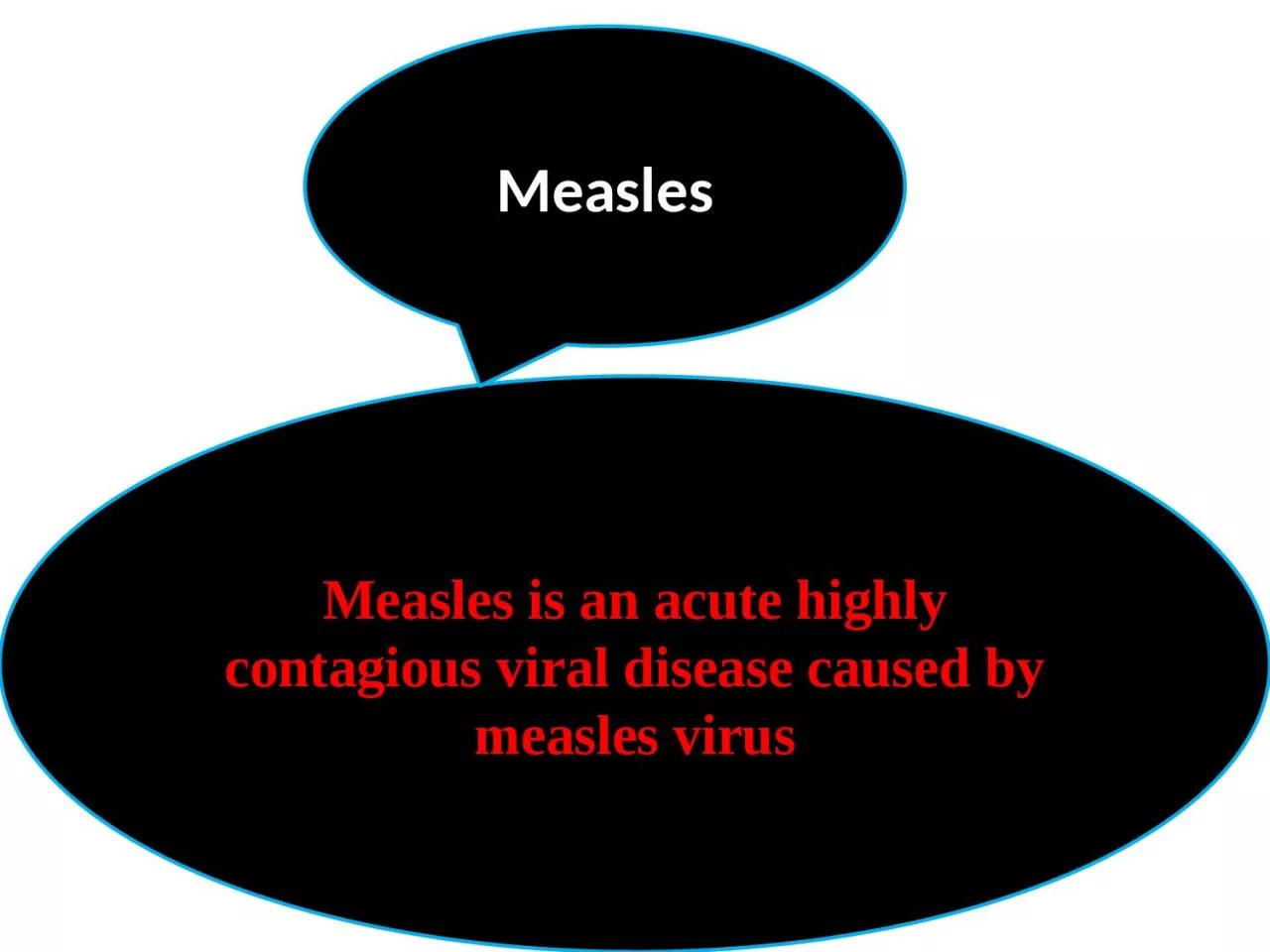

Measles Etiologyagent factor paramyxovirus morbillivirus it is spherical in appearance measuring about 100150nm in diameter It has an outer envelope composed of Mprotein Hprotein Fprotein and internal core is RNA ID: 921117
Download Presentation The PPT/PDF document "Measles is an acute highly contagious vi..." is the property of its rightful owner. Permission is granted to download and print the materials on this web site for personal, non-commercial use only, and to display it on your personal computer provided you do not modify the materials and that you retain all copyright notices contained in the materials. By downloading content from our website, you accept the terms of this agreement.
Slide1
Measles is an acute highly contagious viral disease caused by measles virus
Measles
Slide2Etiology/agent factor
paramyxovirus.
morbillivirus
it is spherical in appearance ,measuring about 100~150nm in diameter
It has an outer envelope composed of M-protein, H-protein, F-protein, and internal core is RNA.
Only one antigenic type of measles virus
is known.
Slide3.
.
Agent factor
Source of infection-cases of measles,
but not carriers
No animal reservoir
Communicability- Highly infectious during
prodromal
period and at the time of eruption
Secondary attack rate- > 80%
Infective period- 3 days before and 5 days after the appearance of rash
Slide4Host factors
Age- 6 months to 3 years even up to 10 years
Incidence equal in both sexes
Immunity – life long immunity
Malnourished children are susceptible
vitamin A deficient -> low mucosal defense
lack of vaccination (need cold chain)
poor hygiene
Slide5↓
PATHOGENESIS
measles virus
respiratory tract
epithelial cells(multiply
lymphoid tissue
blood ( 2ndry
viremia
)
)
general toxic symptoms
Primary
viremia
Reticuloendothelial
cells
Slide6Slide7Clinical features
Prodromal
stage
Eruptive stage
Post-measles
stage
Slide8Measles clinical type
Typical type
Incubation period is approximately 7~18days.
Last 3~4 days.
Fever;
Catarrhal inflammation of URT;
Koplik’s
spots;
conjunctivitis
Atypical
measles
Mild measles
Hemorrhagic
measles
Toxic and shock like measles
Slide9Koplik
‘s spot
Slide10Slide11COMPLICATIONS
Bronchopneumonia
Otitis media
diarrhea
Flare-up of T.B
Myocarditis
Laryngitis;
Encephalitis
SSPE
Slide12Measles encephalitis
1/1000 cases
sequelae
deafness
seizures
mental disorders
Slide13SSPE
sub-acute
sclerosing
panencephalitis
inflammatory disease
defective virus (often lacking M protein
early infection with measles is a risk factor
rare (7/1,000,000 cases of measles
)
decrease since vaccination program
Slide14IMMUNOSUPPRESSION AND MEASLES
TEMPORARY DEPRESSION OF IMMUNE RESPONSE
Tuberculin +
ve
individuals may temporarily become -
ve
MAY GET REACTIVATION OF HERPES, TUBERCULOSIS
Don’t see with vaccine strain
Slide15DIAGNOSIS
Serodiagnosis
Significant increase in
IgG
(need two samples)
Positive for IgM
Isolation
RT-PCR
Slide16DIFFERENTIAL DIAGNOSIS
Rubella (German measles)
Roseola
infantum
(
exanthem
subitum
)
Drug rashes.
Infectious mononucleosis
meningococcemia
Slide17Treatment
Supportive and symptomatic
Vit
-A 2
lacs
IU given orally for 2 days in children older than 1 yr
Treatment of complication
Slide18Prognosis
Self limiting
ds
,unless complicated
Recovery prolonged with respiratory complication
Deaths
may
occur
Mortality
90% of deaths due to respiratory or neurological
Respiratory complication more common in young child
Neurological complication more common in older children
Slide19Prevention
Control source of infection
Interruption of transmissions
.
Protection of the susceptible person
.
1. Active immunization
. Lived attenuated measles vaccine.
2 . Passive immunization
.
gamaglobulin
Slide20Mumps
Mumps is an acute self limiting disease characterized by fever, parotid swelling and tenderness
Slide21Etiology
Paramyxovirus
,
Single stranded R.N.A virus
Single strain known
Human is only reservoir
Slide22Epidemiology
Age : 5-9yrs
Winter and spring
Spread by droplets
Infective period :
7 days before and 7 days after appearance of parotid swelling
Isolation:5dayss after appearance of parotid swelling
Slide23Pathogenesi
s
Infection
Replication in
resp.epithelium
Lymph node
viremia
Salivary glands, CNS ,
pancreas,testis,thyroid,ovaries,heart,kidneys,liver
and
synovia
.
Slide24Clinical features
Incubation period :16-18 days
Asymptomatic to mild non specific symptoms
Typical presentation start with
prodrome
,lasting 1-2 days and consisting of fever, headache, vomiting, body ache,
Parotitis , usually bilateral in 70%
Submandibular gland may also be involved
Slide25Diagnosis
Mainly clinical
Leucopenia with relative
lymphocytosis
,
raised serum amylase
↑
IgG
between acute and convalescent sample
Virus isolation
Slide26Differential diagnosis
Parotid swelling may caused by other infection and noninfectious condition.
Influenza and
para
influenza virus
CMV ,
EBV,enterovirus,HIV
,
Purulent
parotitis
–
S.aureus
.
Obstruction to
stensons duct,collagen
vascular ds
Slide27complication
Abortion
Meningo
-encephalitis
Orchitis
and
oophoritis
pancreatitis
myocarditis
arthritis
thyroiditis
Conjunctivitis
Optic neuritis
nephritis
pneumonia
thrombocytopenia
Slide28Treatment
No specific treatment
Prognosis
Excellent even when complicated by meningoencephalitis
Slide29Prevention
Live attenuated vaccine
Given along with MMR
Efficacy-90%
2 doses ,at 16-18months and at 5 yrs
Slide30Rubella
Slide31Etiology
Slide32Epidemiology
Slide33pathogenesis
Most important risk factor for severe congenital defect is the gestational age at the time of infection
Slide34Clinical manifestation
Slide35Differential diagnosis
Slide36Complication
CRS
Slide37CONGENITAL RUBELLA SYNDROME
In 1941 an ophthalmologist described a syndrome of cataract and congenital heart
ds
associated with maternal infection with rubella.
Slide38CRS contd
……
Slide39Treatment
Slide40Prognosis
Slide41Prevention
Live attenuated RA 27/3 strain
Two doses along with measles and mumps
At 15-18 months and 5yrs
Slide42